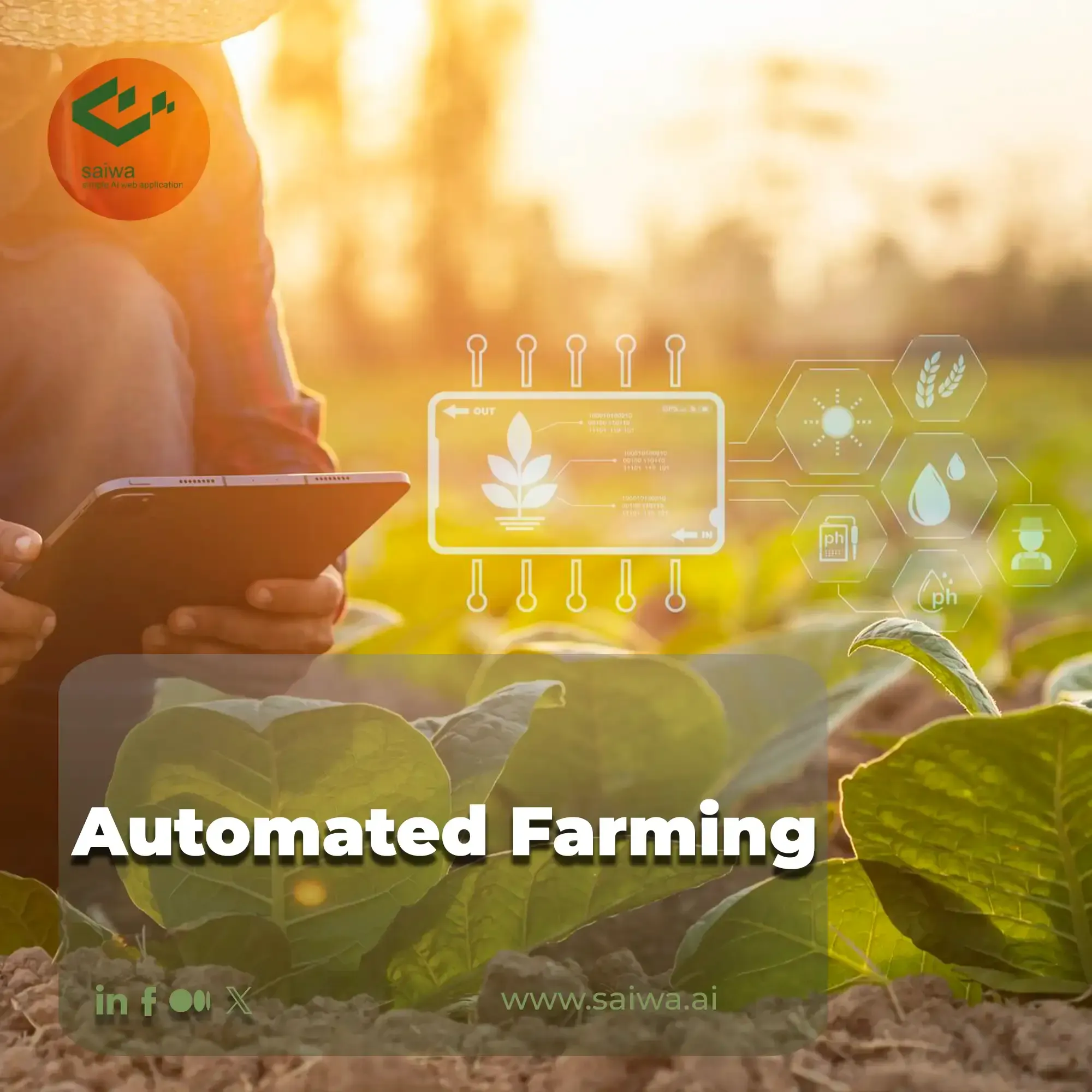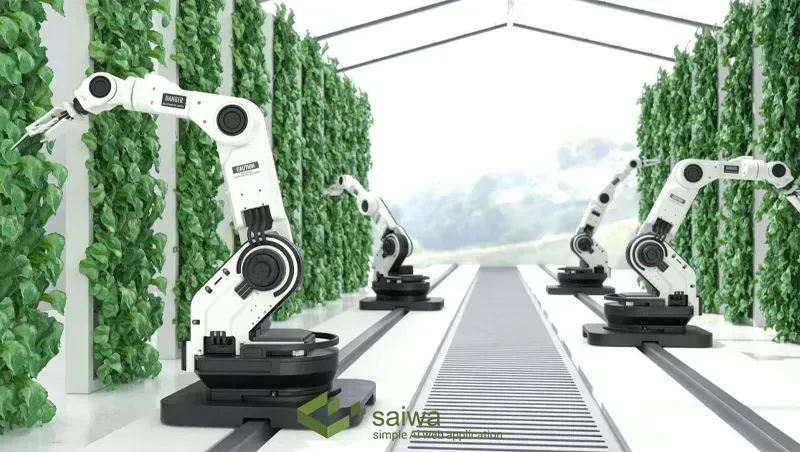Automated Farming - AI-Driven Agriculture Revolution

Global food demand is rising everyday and it is estimated to double by 2070, yet traditional farming faces mounting challenges from labor shortages or climate change. Manual agricultural operations remain labor oriented, with harvesting alone consuming over half of production costs while achieving inconsistent quality and significant crop losses. Small profit margins leave farmers vulnerable to weather, pests, and market fluctuations beyond their control.
Automated farming is changing agriculture through robotics, AI-powered systems, and precision technologies that optimize every stage from planting to harvest. Self-driving tractors, robotic harvesters, and intelligent monitoring systems operate continuously with accuracy impossible for human labor, increasing yields while reducing waste and environmental impact. These technologies transform farming from reactive manual work into proactive, data-driven operations.
This guide contains content concerning the technologies making agricultural automation possible and its applications across crop and livestock production.
What Is Automated Farming?
Automated farming uses artificial intelligence and sensor technologies to optimise crop and livestock production while minimising human intervention in agricultural processes. Unlike traditional farming, which relies heavily on manual labour for planting, monitoring and harvesting, automated systems use intelligent machinery that operates autonomously based on real-time data from sensors, cameras and environmental monitors.
These systems incorporate self-driving tractors, robotic harvesters, automated irrigation networks and drone-based crop monitoring, coordinating these elements to dynamically respond to field conditions. Computer vision can detect weeds, diseases and crop maturity, while machine learning algorithms can fine-tune resource usage and harvest timing. This turns agricultural work into a precise, efficient and data-driven process.

How Is It Important?
Automated farming is key to achieving greater efficiency and sustainability in agricultural production. It helps farmers to overcome labour shortages, reduce costs and increase productivity, all while minimising environmental impact through the optimised use of water, fertilisers and pesticides. By using smart technologies, it helps to ensure stable yields and higher-quality produce, which contributes to global food security and resilience in the face of climate change.
How Automated Farming Operates
Automated agricultural systems work through a systematic three-step mechanism that integrates sensing, analysis, and autonomous action:
- Continuous Monitoring and Detection: Sensors and cameras continuously monitor crops and livestock, detecting problems such as pest infestations, diseases, irrigation needs, or equipment malfunctions across fields and facilities.
- Intelligent Data Analysis and Recommendations: Software systems analyze collected data using machine learning algorithms to identify optimal solutions, generating recommendations for irrigation schedules, fertilizer application rates, pest management strategies, or harvest timing.
- Autonomous Execution: Automated machinery converts software recommendations into physical actions, with robots and autonomous equipment performing tasks like precision watering, targeted pesticide application, or harvesting without human intervention.
This closed-loop workflow enables 24/7 agricultural operations that respond instantly to field conditions.
Read Also: AI in Agriculture | Practical Application & Future of AI in Agriculture
How Agriculture Benefits from Automated Farming In Action
Automated technologies deliver transformative capabilities across diverse agricultural operations:
- Autonomous Harvest Operations: Robotic harvesters equipped with computer vision identify ripe fruits or vegetables, gently pick produce without damage, and operate continuously regardless of weather or time. Hyperspectral imaging detects sweetness levels and nutrient richness, ensuring only premium produce gets harvested while minimizing premature picking and losses.
- Precision Seeding and Weeding: GPS-guided equipment plants seeds at exact depths and spacing optimized for soil conditions, while computer vision-equipped robots identify and target weeds specifically. This precision reduces herbicide use by up to 90% compared to broadcast spraying methods while improving germination rates.
- Intelligent Drone Monitoring: Aerial drones equipped with visual, hyperspectral, and thermal cameras scan vast acreage identifying irrigation needs, diseases, yield rates, and crop health indicators. Infrared analysis quickly spots problem areas, enabling farmers to address issues before they spread across fields.
- Automated Livestock Management: Robotic milking systems allow animals to self-schedule milking while collecting health data, automated feeding dispenses customized rations based on individual needs, and wearable sensors track vital signs for early illness detection without constant human observation.
Read Also: Automated Agriculture Irrigation Systems

Tools Behind Automated Farming
Several specialized technologies enable effective agricultural automation:
- Computer Vision and Deep Learning: CNNs analyze imagery from cameras and drones to assess crop maturity, detect diseases, identify weeds, and guide robotic harvesters through precise fruit selection based on size, color, and firmness indicators.
- GPS and RTK Navigation: Real-time kinematic positioning enables centimeter-level accuracy for autonomous tractors, ensuring precise planting rows, preventing overlaps, and optimizing field coverage patterns that maximize efficiency.
- Robotic Manipulation Systems: Advanced grippers with polyurethane conformal foam linings adapt to delicate produce shapes, using adjustable tension settings that prevent damage while enabling multiple-item grasping that boosts harvesting efficiency per cycle.
- IoT Sensor Networks: Ground robots with soil probes, moisture sensors, and cameras create detailed field data models informing irrigation, fertilization, and pesticide applications tailored to micro-conditions across different zones.
- 5G and Edge Computing: Ultra-low latency networks enable split-second autonomous decision-making, while edge processing performs critical calculations directly on equipment without cloud dependency, ensuring reliable operation in remote areas.
- Fleet Management Software: Orchestration platforms coordinate multiple autonomous machines using real-time ripeness sensing, terrain accessibility data, and obstruction hazard information to optimize task assignments and maximize productivity across large operations.
Read More: AI-Based Drone Operation| AI in Drones use cases
Sensors and Data Collection in Automated Farming Equipment
A range of nimble ground and aerial robots outfitted with different sensors produce valuable crop data:
- Aerial drones using visual, hyperspectral, and thermal cameras identify irrigation needs, diseases, yield rates, and other crop health clues throughout the season by scanning vast acreage from the sky.
- Ground robots equipped with probes to test soil chemistry, moisture sensors, and cameras create mapped field data models, informing irrigation, fertilizer, and pesticide applications tailored to micro-conditions.
- Passive monitoring systems track indicators like frost risk, wind damage, humidity, and equipment operations.
- Cloud-based data management platforms aggregate, analyze, and act on insights gathered autonomously in the field.
Upsides and Downsides
While these automated bring so much to the table and have so many benefits there are, as usual, some downsides to consider.
Upsides
Automated farming delivers substantial operational improvements over traditional manual methods:
- Dramatic Labor Cost Reduction: Automation addresses workforce shortages affecting over 50% of farms while reducing labor expenses that constitute more than half of operational costs, allowing reallocation to complex tasks requiring human expertise.
- Superior Efficiency and Precision: GPS-guided equipment and robotic harvesters operate with optimized precision unmatched by humans, minimizing errors, reducing waste, and enabling real-time adaptation to changing field conditions throughout growing seasons.
- 24/7 Continuous Operations: Robotic equipment operates around the clock regardless of weather, darkness, or fatigue, maximizing productivity during critical planting and harvest windows when timing directly impacts yields and quality.
- Data-Driven Decision Support: Onboard sensors collect vast datasets revealing insights about crop stress, soil deficiencies, and pest infestations. Real-time analysis enables proactive intervention while accumulated data supports predictive analytics and long-term planning.
- Enhanced Profitability: Despite upfront equipment investments, reduced labor costs and increased efficiency improve profit margins significantly. Return on investment grows as technology evolves, making automation financially viable across farm sizes.
Downsides
Agricultural operations adopting automation must address several significant obstacles:
- High Initial Investment Costs: Robotic harvesters, autonomous tractors, and sensor infrastructure require substantial capital ranging from tens of thousands to millions of dollars, creating barriers particularly for small farms and operations in developing countries.
- Equipment Specialization Limitations: Most automated machinery performs specific tasks like tomato harvesting or lettuce cutting, requiring multiple expensive systems rather than versatile equipment adaptable across different crops or farming operations.
- Maintenance and Repair Challenges: Breakdowns during critical periods cause devastating losses, yet specialized equipment often requires manufacturer technicians rather than local repair services, creating dependencies and potential downtime risks.
- Integration with Existing Operations: Incorporating autonomous systems into established workflows, infrastructure, and traditional equipment can be complex, requiring operational restructuring and compatibility considerations that complicate adoption.
- Infrastructure Dependencies: Many automated systems require reliable internet for data transmission and cloud processing, yet rural agricultural areas often lack adequate broadband infrastructure necessary for optimal system performance.
Conclusion
Automated farming transforms agriculture from labor-intensive manual work into intelligent, efficient operations powered by robotics and artificial intelligence. These technologies address fundamental challenges facing modern agriculture, from labor shortages to environmental sustainability, while increasing productivity and profitability for operations of all sizes.
Looking ahead, the future of automated farming will be defined not only by robotics and autonomous machinery, but by the intelligence that coordinates them. At Saiwa, we see AI-driven perception and decision-making as the core enabler of scalable, reliable agricultural automation. Our product Sairone with its advanced computer vision models for crop detection, yield estimation, and ripeness analysis demonstrates how AI can translate complex field conditions into precise, actionable insights that machinery can execute autonomously.
As farms adopt automation at increasing scale, the ability to process visual data in real-time, adapt to crop variability, and optimize harvest timing becomes essential. Industries that delay integrating these intelligence layers risk falling behind operating with lower efficiency, higher waste, and reduced competitive advantage.
In our view, the next generation of agriculture belongs to systems where AI doesn’t just assist the process but orchestrates it, enabling farms of all sizes to achieve consistent productivity even under climate uncertainty and labor constraints.
Note: Some visuals on this blog post were generated using AI tools.
